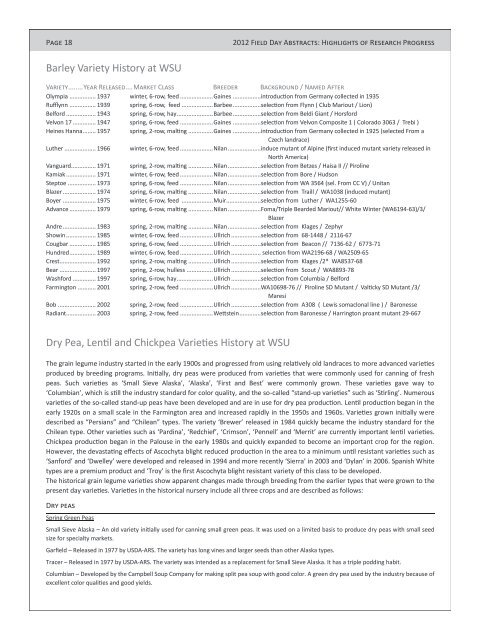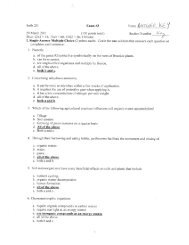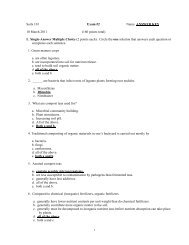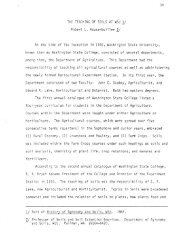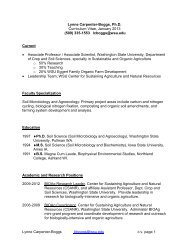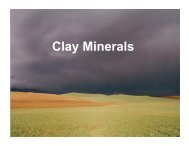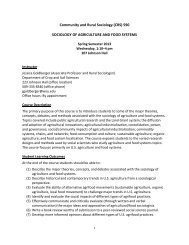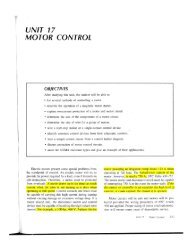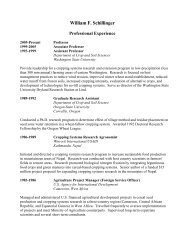2012 Dryland Field Day Abstracts - Dept. of Crop and Soil Sciences ...
2012 Dryland Field Day Abstracts - Dept. of Crop and Soil Sciences ...
2012 Dryland Field Day Abstracts - Dept. of Crop and Soil Sciences ...
You also want an ePaper? Increase the reach of your titles
YUMPU automatically turns print PDFs into web optimized ePapers that Google loves.
Page 18<br />
Barley Variety History at WSU<br />
<strong>2012</strong> <strong>Field</strong> <strong>Day</strong> <strong>Abstracts</strong>: Highlights <strong>of</strong> Research Progress<br />
Variety ........ Year Released .... Market Class Breeder Background / Named After<br />
Olympia ................ 1937 winter, 6-row, feed .................... Gaines .................introduction from Germany collected in 1935<br />
Rufflynn ................ 1939 spring, 6-row, feed ................... Barbee .................selection from Flynn ( Club Mariout / Lion)<br />
Belford .................. 1943 spring, 6-row, hay ...................... Barbee .................selection from Beldi Giant / Horsford<br />
Velvon 17 .............. 1947 spring, 6-row, feed .................... Gaines .................selection from Velvon Composite 1 ( Colorado 3063 / Trebi )<br />
Heines Hanna ........ 1957 spring, 2-row, malting ............... Gaines .................introduction from Germany collected in 1925 (selected From a<br />
Czech l<strong>and</strong>race)<br />
Luther ................... 1966 winter, 6-row, feed .................... Nilan ....................induce mutant <strong>of</strong> Alpine (first induced mutant variety released in<br />
North America)<br />
Vanguard ............... 1971 spring, 2-row, malting ............... Nilan ....................selection from Betzes / Haisa II // Piroline<br />
Kamiak .................. 1971 winter, 6-row, feed .................... Nilan ....................selection from Bore / Hudson<br />
Steptoe ................. 1973 spring, 6-row, feed .................... Nilan ....................selection from WA 3564 (sel. From CC V) / Unitan<br />
Blazer .................... 1974 spring, 6-row, malting ............... Nilan ....................selection from Traill / WA1038 (induced mutant)<br />
Boyer .................... 1975 winter, 6-row, feed ................... Muir.....................selection from Luther / WA1255-60<br />
Advance ................ 1979 spring, 6-row, malting ............... Nilan ....................Foma/Triple Bearded Mariout// White Winter (WA6194-63)/3/<br />
Blazer<br />
Andre .................... 1983 spring, 2-row, malting ............... Nilan ....................selection from Klages / Zephyr<br />
Showin .................. 1985 winter, 6-row, feed .................... Ullrich ..................selection from 68-1448 / 2116-67<br />
Cougbar ................ 1985 spring, 6-row, feed .................... Ullrich ..................selection from Beacon // 7136-62 / 6773-71<br />
Hundred ................ 1989 winter, 6-row, feed .................... Ullrich .................. selection from WA2196-68 / WA2509-65<br />
Crest...................... 1992 spring, 2-row, malting ............... Ullrich ..................selection from Klages /2* WA8537-68<br />
Bear ...................... 1997 spring, 2-row, hulless ................ Ullrich ..................selection from Scout / WA8893-78<br />
Washford .............. 1997 spring, 6-row, hay ...................... Ullrich ..................selection from Columbia / Belford<br />
Farmington ........... 2001 spring, 2-row, feed .................... Ullrich ..................WA10698-76 // Piroline SD Mutant / Valticky SD Mutant /3/<br />
Maresi<br />
Bob ....................... 2002 spring, 2-row, feed .................... Ullrich ..................selection from A308 ( Lewis somaclonal line ) / Baronesse<br />
Radiant.................. 2003 spring, 2-row, feed .................... Wettstein .............selection from Baronesse / Harrington proant mutant 29-667<br />
Dry Pea, Lentil <strong>and</strong> Chickpea Varieties History at WSU<br />
The grain legume industry started in the early 1900s <strong>and</strong> progressed from using relatively old l<strong>and</strong>races to more advanced varieties<br />
produced by breeding programs. Initially, dry peas were produced from varieties that were commonly used for canning <strong>of</strong> fresh<br />
peas. Such varieties as ‘Small Sieve Alaska’, ‘Alaska’, ‘First <strong>and</strong> Best’ were commonly grown. These varieties gave way to<br />
‘Columbian’, which is still the industry st<strong>and</strong>ard for color quality, <strong>and</strong> the so-called “st<strong>and</strong>-up varieties” such as ‘Stirling’. Numerous<br />
varieties <strong>of</strong> the so-called st<strong>and</strong>-up peas have been developed <strong>and</strong> are in use for dry pea production. Lentil production began in the<br />
early 1920s on a small scale in the Farmington area <strong>and</strong> increased rapidly in the 1950s <strong>and</strong> 1960s. Varieties grown initially were<br />
described as “Persians” <strong>and</strong> “Chilean” types. The variety ‘Brewer’ released in 1984 quickly became the industry st<strong>and</strong>ard for the<br />
Chilean type. Other varieties such as ‘Pardina’, ‘Redchief’, ‘Crimson’, ‘Pennell’ <strong>and</strong> ‘Merrit’ are currently important lentil varieties.<br />
Chickpea production began in the Palouse in the early 1980s <strong>and</strong> quickly exp<strong>and</strong>ed to become an important crop for the region.<br />
However, the devastating effects <strong>of</strong> Ascochyta blight reduced production in the area to a minimum until resistant varieties such as<br />
‘Sanford’ <strong>and</strong> ‘Dwelley’ were developed <strong>and</strong> released in 1994 <strong>and</strong> more recently ‘Sierra’ in 2003 <strong>and</strong> ‘Dylan’ in 2006. Spanish White<br />
types are a premium product <strong>and</strong> ‘Troy’ is the first Ascochyta blight resistant variety <strong>of</strong> this class to be developed.<br />
The historical grain legume varieties show apparent changes made through breeding from the earlier types that were grown to the<br />
present day varieties. Varieties in the historical nursery include all three crops <strong>and</strong> are described as follows:<br />
Dry peas<br />
Spring Green Peas<br />
Small Sieve Alaska – An old variety initially used for canning small green peas. It was used on a limited basis to produce dry peas with small seed<br />
size for specialty markets.<br />
Garfield – Released in 1977 by USDA-ARS. The variety has long vines <strong>and</strong> larger seeds than other Alaska types.<br />
Tracer – Released in 1977 by USDA-ARS. The variety was intended as a replacement for Small Sieve Alaska. It has a triple podding habit.<br />
Columbian – Developed by the Campbell Soup Company for making split pea soup with good color. A green dry pea used by the industry because <strong>of</strong><br />
excellent color qualities <strong>and</strong> good yields.


